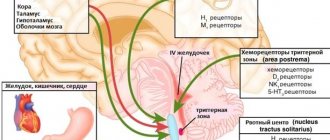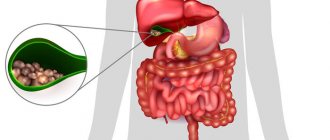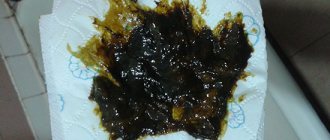Major diseases
Typically, vomiting of coffee grounds occurs during bleeding (gastroduodenal) of various origins. In addition, the following diseases can lead to the development of such a symptom:
- peptic ulcer of the gastrointestinal tract;
- Mallory-Weiss syndrome;
- gastric erosion;
- malignant tumors and polyps of the stomach;
- cardia or so-called openings in the stomach (in the cardiac region);
- varicose veins of the esophagus;
- damage to the esophagus by foreign bodies;
- cirrhosis of the liver, which occurs with impaired blood circulation;
- poisoning with poisonous mushrooms, chemicals, alcohol substitutes and others.
General clinical picture
Brown vomiting does not occur unexpectedly in a person; usually this condition is preceded by certain signs in which the person’s health steadily deteriorates.
- Unmotivated weakness and dizziness.
- Heavy sweating.
- Fainting state.
- Increased heart rate.
- Persistent decrease in blood pressure.
- Pain in the stomach area.
- Severe diarrhea.
When there is bleeding in the stomach and intestines, a certain amount of digested blood enters the stool, causing it to turn black. The consistency of such feces is tarry. Extensive and sudden bleeding can lead to severe anemia and even collapse.
Characteristics of vomiting
Vomiting coffee grounds does not occur on its own. Usually its formation is preceded by a pathological deterioration in the patient's condition.
Depending on the cause of the bleeding (gastrointestinal), the main signs of this pathological condition are the following:
- black stool, which indicates the passage of blood through the entire digestive tract;
- pain in the epigastric region (as a rule, this symptom indicates the presence of a bleeding ulcer in the stomach);
- fainting, a sharp drop in blood pressure, tachycardia (such signs indicate heavy gastrointestinal bleeding).
It should also be noted that very often dark red or scarlet bloody clots are found in the brown or brown vomit that the patient regurgitates. Usually, after such an observation, bloody vomiting occurs, which threatens the patient’s life.
Home remedies for the problem
Vomiting black liquid, what it is and whether it can be dealt with at home, everyone who has encountered it will ask. Self-medication is allowed if the cause of vomiting is not a disease of the gastrointestinal tract or cancer. For food poisoning accompanied by dark discharge from the stomach, use:
- Two to three ripe peaches.
- Drink half a glass of red currant juice.
- Potato juice. To obtain juice, potatoes are grated or crushed in a blender, and the potato mass is squeezed through cheesecloth.
- Infusion of lemon zest and alcohol. Pour the peels of three lemons with half a glass of alcohol and 200 ml of water. Leave for three days in a dark place.
Black vomiting occurs more often in healthy people. But some cases of its occurrence require medical attention.
Let’s figure out what diseases the symptom signals, how to help in this situation, and how doctors treat patients with black vomit.
Treatment process
Vomit the color of coffee grounds is quite rare. But if it does occur, it is not recommended to delay its treatment. This is due to the fact that such a condition can lead to the death of the patient.
If you or a loved one are vomiting coffee grounds, you should call an ambulance as an emergency. Until this moment (that is, until the doctors arrive), the sick person should lie motionless on the bed. At the same time, eating any food or drinking ordinary water is strictly prohibited.
To alleviate the patient's condition, it is necessary to place a thick ice pack on the abdominal area. This procedure should significantly reduce bleeding.
As soon as the patient is transported to a medical facility, the specialist must immediately begin to find out the reason that caused the accumulation of blood in the stomach. The sooner it is detected, the faster the patient’s condition will return to normal.
Thus, we can safely note that it is not the symptom in the form of vomiting that is treated, but the underlying disease that caused it.
Typically, the actions of medical specialists regarding a patient with the pathological phenomenon in question include the following activities:
- the process of replenishing blood volume, especially with large blood loss over a long period of time;
- identifying the causes of vomiting and the source of bleeding;
- process of stopping bleeding.
The latter includes the use of various medications prescribed by a doctor. If there is an urgent need, the patient is prescribed surgery.
https://youtu.be/rEFDyP_drOY
Vomiting of coffee grounds is a reflex gastric eruption of black-brown masses, indicating internal bleeding.
In accordance with a conventional scale reflecting the nature and degree of severity, it is vomiting coffee grounds, as well as vomiting mixed with blood, that poses a mortal threat to human life.
Article navigation
Help for the victim
At the first sign of bleeding, immediately call an ambulance.
While doctors are on the road, take first aid measures:
- Do not hold back or force vomiting.
- Place the patient on the sofa; Place a cushion under his head, turned to one side.
- Elevate the patient's legs above heart level to promote blood flow to the brain.
- Give him only cold water or pieces of ice.
- Place the cold on your stomach.
Collect vomit to show to your doctor. This will help determine the location of the bleeding.
If dark-colored gastric secretions occur due to foods, it is recommended to exclude them from the diet. Do not use medications that cause dark vomit. If vomiting occurs once, and the body temperature does not increase, a number of actions should be taken:
- Rinse the stomach. Dissolve four to five granules of potassium permanganate in a liter of boiled, cooled water. Drink in large sips. If vomiting does not occur, induce using your fingers by pressing on the root of the tongue.
- To avoid dehydration, stir a sachet of Regidron in a liter of water. The drug helps restore water and electrolyte balance. Divide the content into five steps.
- Place the victim on his right side.
- Provide peace.
- Turn your head to the left or right side so that vomit does not interfere with respiratory activity.
- Avoid eating while vomiting.
At the first sign of bleeding, immediately call an ambulance.
If a person experiences black vomiting, then you should immediately call an ambulance, especially if this condition occurs in a small child or an elderly person. The help algorithm looks like this:
- The patient is placed comfortably in bed and provided with complete rest. The person should lie horizontally on a low pillow. If vomiting occurs periodically, members of the household help lift the patient or turn him on his side.
- Place a heating pad with ice water or finely crushed ice on the stomach area. The heating pad is first wrapped in a thin towel or cotton napkin.
- A patient with dark vomiting is not allowed to eat, drink, or take medications that can smooth out the clinical picture.
Diseases accompanied by vomiting coffee grounds
This symptom occurs with gastroduodenal bleeding of various etiologies.
Among the diseases and conditions that can lead to vomiting coffee grounds, the following should be noted:
- Peptic ulcer of the stomach and duodenum;
- Polyps and malignant tumors of the stomach;
- Varicose veins of the esophagus and cardia (the opening in the cardiac part of the stomach that connects to the esophagus);
- Erosion of the stomach;
- Mallory–Weiss syndrome;
- Liver cirrhosis – (read more about liver cirrhosis here) in which the circulation of blood coming from the lower part of the body through the liver is disrupted. Blood begins to pass through the vessels of the anterior abdominal wall, the veins of the esophagus, which, as the disease progresses, will lead to decompensation and bleeding from dilated veins;
- Damage to the esophagus by sharp foreign bodies (pins, needles, splintered bone fragments, etc.);
- Poisoning with poisonous mushrooms (white toadstools), alcohol substitutes, etc.
How does coffee-ground vomiting manifest?
Vomiting of coffee grounds is usually preceded by severe deterioration of the condition.
Depending on the cause of gastrointestinal bleeding, the clinical picture may include: – epigastric pain (bleeding gastric ulcer); – black stool – melena, indicating the passage of blood through the intestinal tract; – tachycardia, fainting, sharp decrease in blood pressure – with heavy gastrointestinal bleeding.
Scarlet or dark red, bloody clots are often found in brownish-brown vomit. As a rule, after vomiting coffee grounds in such cases, bloody vomiting occurs.
What consequences can you expect?
The outcome of black vomit depends on the intensity of the bleeding. Every second patient with alcoholic cirrhosis experiences death.
With Mallory-Weiss syndrome, bleeding may begin. You can't leave a drunk person at home alone. It is necessary to take him to the hospital. Moderate gastric bleeding is treated using electrocoagulation, vessel ligation, and clipping.
What awaits the victim with black vomit depends on how much blood was lost during gastric or intestinal hemorrhage. If a person has lost a small amount of blood, the consequence is a mild degree of anemia. If anemia is detected early and appropriate therapy is prescribed, health consequences can be avoided.
If the hemorrhage appears suddenly and a lot of blood is lost, this contributes to the occurrence of hemorrhagic shock. It is characterized by the appearance of pale skin and mucous membranes, rapid heartbeat and low blood pressure.
https://www.youtube.com/watch?v=FZNeu0GUE8o
The internal organs are not supplied with the required amount of oxygen, which is transported by red blood cells. This develops severe hypoxia. Lack of oxygen requires medical attention.
With a large amount of blood lost, the risk of kidney failure increases. This is explained by the fact that the filtering of blood by the kidneys occurs if the required level of blood pressure is present. When pressure decreases, the kidneys stop functioning.
Treatment for vomiting coffee grounds
If vomiting coffee grounds occurs, you must urgently call emergency services. The person must lie still until doctors arrive. Eating food is strictly prohibited!
An ice pack should be placed on the abdominal area to reduce bleeding. After transporting the person to a medical facility, the reason that caused the accumulation of blood in the stomach will be determined. Thus, the underlying disease is treated.
In general, the actions of medical professionals may include the following activities:
- replenishment of blood volume - in case of large blood loss;
- identifying the source of bleeding;
- stop bleeding.
Vomiting occurs after involuntary contraction of the abdominal muscles. The reflex process helps cleanse the digestive tract if the body has been exposed to poisoning, infection or toxins.
Factors causing vomiting
The cause of vomiting with blood clots is dysfunction of internal organs. A pathological malfunction in the functioning of the gastrointestinal tract provokes an uncontrollable eruption. Disease of the upper (stomach, duodenum, esophagus) or lower (colon, small intestine, rectum) parts is characterized by bleeding. The amount of blood affects the nature of the vomiting process. Blood loss is distinguished:
- Hidden - detected in laboratory conditions.
- Acute (single appearance of more than half a liter of biomaterial).
- Chronic – the body loses about 50 ml of biological fluid every day.
The color of the grounds varies from scarlet to black-brown. Vomiting red contents indicates bleeding in the upper gastrointestinal tract. A dark shade indicates that blood has been in the stomach for a long time. Hydrochloric acid, the contents of gastric juice, participates in a reaction with the blood. The iron in red blood cells that carry hemoglobin sticks to chlorine. Hematin chloride is formed. The brownish-colored compound precipitates in the stomach cavity.
Diagnosis by the color of vomit
The color shade of the masses expelled by the stomach is one of the key points in the diagnosis of diseases of the stomach or intestines, as well as pathologies of other organs. It can tell you both about the types of foods eaten or drinks drunk, and about the presence of chronic infectious foci, neoplasms, parasites and other pathological conditions in the body. The colors of vomit encountered in medical practice can be divided into the following:
The most common color of vomit is yellow-green or green. It may depend primarily on the food eaten. For example, if a person has eaten too much bananas, then the food masses will be yellow; if there are fresh cucumbers, herbs or green fruits, then the contents of the stomach will have a green tint. At the same time, green or yellow pieces of food are clearly visible in the vomit. But there are a number of diseases in which vomiting green masses, abundant or scanty, evenly colored, is a diagnostic criterion.
The most common disease is gastroenteritis of an infectious nature. Ingestion of foods contaminated with salmonella, staphylococcus, and E. coli into the stomach leads to the development of inflammation of the mucous membrane of the digestive tract and weakening of the sphincters, which under normal conditions prevent the reflux of bile into the stomach. As a result, bile ends up in the stomach cavity, mixes with food and ends up in the vomit, turning it green. When there is no food left in the stomach, bile is thrown out, mixing with mucus.
But bile can enter the stomach, and then into the vomit, and in other pathologies. These include acute or chronic cholecystitis (especially calculous, with the formation of stones), the condition after removal of the gallbladder, biliary dyskinesia, diseases of the liver and pancreas. In these conditions, vomiting is always accompanied by other characteristic symptoms, the complex of which allows an accurate diagnosis to be made.
Some foods can turn vomit red. For example, if a person has eaten a lot of red berries or fruits, they will be visible as colored food debris. But in most cases, blood gives the red color to vomit. It can be present as individual bright red streaks, or it can be in significant quantities, and in the most severe cases, the vomit consists entirely of blood.
This is a very unfavorable prognostic sign that threatens a person’s life, since a lot of blood is lost in a short period of time, and the source of bleeding is very difficult to block. Therefore, if vomiting with blood occurs, emergency hospitalization of the patient is necessary.
If the color of the vomit is bright red, without a brown tint, then this means that the bleeding occurs from areas close to the esophagus or located in it itself. This can happen when:
- mechanical damage to the mucous membrane of the esophagus or stomach;
- rupture of dilated veins of the esophagus due to varicose veins;
- tumors of the esophagus or stomach;
- erosions or ulcers of the esophagus or parts of the stomach close to the cardia;
- acute gastritis caused by excessive intake of alcoholic beverages.
If vomiting of this color appears, urgent medical attention and further in-depth examination of the patient are necessary. Its purpose is to urgently identify the source of bleeding and stop blood loss, which can quickly lead to severe anemia and threaten life. Black or brown vomiting is a manifestation of the following diseases:
- ulcers of the duodenum or parts of the stomach close to the pylorus;
- tumors of the stomach or small intestine;
- digestive tract injuries;
- chronic alcoholism;
- uncontrolled use of certain medications (aspirin, indomethacin, steroids);
- intestinal obstruction caused by a tumor, intussusception or parasites; in this case, the vomit is fecal in nature and has a characteristic color and smell.
https://youtu.be/pujTYVg7b4E
Medical rationale for the process
Vomiting coffee grounds is almost asymptomatic. The patient's condition worsens suddenly and is accompanied by lethargy and dizziness. Blood pressure decreases due to increased heart rate. A person may lose blood during bowel movements, in addition to passing red blood cells through vomiting. Bloody stool has a thick, blackish consistency. The brighter the blood clots, the closer the damaged organ. Such discharge may indicate diseases of the lower gastrointestinal tract.
Heavy blood loss often provokes posthemorrhagic anemia. The consequences are acute vascular failure. Symptoms: shortness of breath, rapid heartbeat, dizziness, fainting.
When a person vomits coffee, the body is in serious danger. The first step is to call an ambulance. Before the doctors arrive, the patient needs first aid. Washing is prohibited.
How to help someone suffering from dark, sometimes black, vomiting:
- Provide the sick person with a horizontal position.
- Place the patient on his side. Raise your legs above head level.
- Eliminate psychological and physiological discomfort.
- Apply cold compresses to the epigastric area.
- Ventilate the room.
- Protect from food, liquids and medications. The stomach needs rest.
- Calm down a person frightened by his condition.
It is important to collect the vomit with bloody flakes in a sterile container. Close the lid tightly and write when and at what time the biomaterial was collected. The patient's personal information is required. Thus, the laboratory will determine the cause of vomiting.
Urgent hospitalization in a medical facility will help to quickly determine the diagnosis. The phenomenon when a person vomits chocolate-colored thickets signals serious gastrointestinal diseases. The cause of the pathological condition in an elderly or young patient will be determined in the laboratory at the hospital. The doctor will prescribe an endoscopy of the stomach under painkillers. The insertion of a thin tube with a video camera may indicate changes in the mucosa and disturbances in the functioning of the esophagus.
The second procedure for examining the gastrointestinal tract in humans is endoluminal sonography. Examination of the rectum using ultrasound by inserting a camera at the end of the tube through the anus.
Blood is taken from the patient to determine liver damage. Examination of stool helps identify hidden blood discharge. A barium examination is performed so that the X-ray image excludes or shows the presence of tumors in cancer of the gastrointestinal tract. The doctor prescribes treatment, determines the regimen of restorative procedures and nutrition after identifying the true cause of granular black vomiting.
Review of remedies for illness
If the cause of dark vomiting is a disease of the digestive organs, the patient is prescribed:
- Cerucal. The dosage ranges from 1 to 3 tablets or ampoules per day. Depends on the severity of the disease.
- Metoclopramide. Taking two tablets no more than four times a day or intramuscular injection of 20 mg no more than three times a day.
If black vomiting is caused by ethanol poisoning, the following drugs are prescribed:
- Atoxil, Sorbex, Polysorb, which are necessary to rid the gastrointestinal tract of toxins. They can stop not only vomiting, but also relieve loose stools.
- To stop vomiting and retching, raglan, cerucal or motilium are prescribed.
- Intravenous administration of Ringer's solution helps to avoid dehydration.
If black vomiting in an elderly person is caused by cancer, the doctor will prescribe the following medications:
- Polysorb, coal, sorbex. Indicated for intoxication of the body due to the disintegration of a malignant formation.
- Treatment with Ondansetron, Metoclopramide and Granisetron is necessary if gastric obstruction occurs or after chemotherapy.
- The administration of Olanzaline, Dexamethasone, and Quetialin is necessary when metastases appear.
- If the level of calcium in the body is elevated, treatment with Haloperidol is indicated.
Treatment
Prevention of diseases that cause involuntary eruption of brown liquid from the stomach is almost impossible. Analyzes and examinations do not predict the time zone of the risk of such a process.
The doctor diagnoses the factors causing bleeding by studying the medical history. A person should talk about chronic diseases, how he eats, the presence of bad habits, hereditary pathologies and other information.
The body needs to stop bleeding and replenish lost blood volume. Droppers with solutions of medications will help normalize blood pressure and support the body. The patient is brought out of shock and digestive functions are brought back to normal.
The first day the patient is supposed to fast. The strictest diet is based on eating foods that are easy for the body. Liquid foods, low-fat dairy products, egg whites, all kinds of jellies are indicated during the recovery period.











